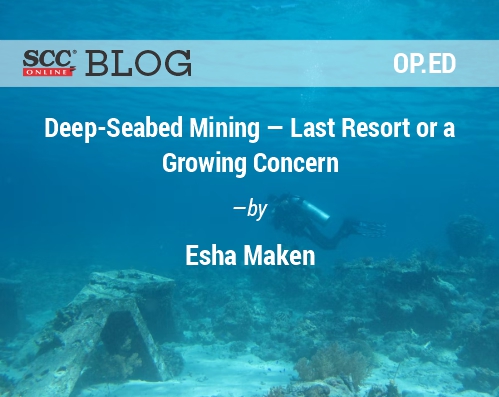Smallest island all set to take on the world
The world's smallest island Nauru1 has taken the lead by taking one of the biggest decisions concerning ocean resources. The country, through a proclamation; has announced that it would start mining the deep sea by early 2023. The four-page declaration to begin extracting the minerals from the depth of the ocean floors, though highly ambitious, has set in motion the desire to exploit2 seabed resources. The technology to harvest the much-in-demand polymetallic nodules is still in the developing stage but the island nation seems determined to outpace the developed world still busy debating whether deep-seabed mining is a solution or an unforeseen peril.
It is well known that deep-seabed mining activities open an arena of opportunities for meeting the increasing needs of minerals and resources for future generations. It simultaneously poses threat to the environment and underwater aquatic and plant life. The deep seabed is one of the coldest and darkest places on the planet earth and very little of which has been actually traversed. With a diversified marine life and ecosystem remaining yet to be discovered, jumping into the practice of deep-seabed mining could lead to the endangerment of the natural habitat that lies beneath the oceans. One of the most severe impacts of this activity could be that many species could be wiped out and many may perish which humankind is yet to discover.
Rising metal prices, depleting terrestrial metal deposits and the “new resource frontier”
In another remarkable development, the nickel prices3 in global market suddenly shot up in the month of March this year. There was a widespread panic around the world adding to the unpredictability of the metal market. With Russia's invasion of Ukraine, the demand and supply of the nickel has been heavily disrupted since Russia is a leading producer of high quality nickel in the world. Consequently, deep-seabed mining has attracted the attention of the metal industry as mining the deep ocean beds could conceivably help meeting demand and supply of the metals like sulphide, manganese, and polymetallic nodules.
The deep seabed can potentially help in dealing with the surging demand for metals and furthermore the depleting terrestrial deposit for metals is constantly resulting in the growing interest in the mineral deposits beneath the oceans and the seas. The rising demand for metals has pushed the States to explore the seabed that is known to contain an abundance of metal-rich resources. Therefore, the depths of the oceans are now the new destination or the “new resource frontier”. The deep sea floors are presumed to be rich in mineral resources like sulphide, manganese, and polymetallic nodules. With the extraction of these minerals, the global community can find alternative sources of fossil fuels with the potential to add to the economic wealth but the impact on the environment merits serious attention.
India and deep-seabed mining
With its “Deep Ocean Mission”4, India has recently announced is a noteworthy development towards deep-seabed mining. The Union Ministry of Earth Sciences, the Nodal Department for the Deep Ocean Mission, has assured commitment in maintaining a balance between the marine ecology and the resource security of the country. With the proper procedure followed, approval getting cleared by the Cabinet Committee on Economic Affairs and a reasonable amount of budget allotted by the Prime Minister of the country, the mission is set to be implemented phase-wise over the next five years.
It merits mention that the scientists of the National Institute of Ocean Technology (NIOT) have developed Varaha-15, a mining machine which could be crucial for all the plans that India has for its future activities in the deep sea area.
Is the world really prepared?
While discussions about the activity of deep-seabed mining are important as well as interesting, the risk of how it could be affecting the deep ocean floors, the flora and fauna, and the entire ecosystem require careful understanding. A systematic and comprehensive baseline study, high-quality environmental assessment along with the pre-planned testing of the machines to be used for mining are some of the basic approaches before India can carry out a fully-fledged deep-sea mining activity.
Even though scientists, researchers, policymakers, and environmentalists around the world are engrossed in developing and coming up with the best suited modus operandi for carrying out the activities of deep-seabed mining, taking the first step towards actually engaging in the activity remains “mysterious” as the practice of deep-sea mining is a tussle between the known and the unknown. Furthermore, the hunger for discovery and environmental and ecological dangers associated with deep-sea mining is unfathomed. Only time can tell if humankind is actually prepared for what lies ahead, beyond and beneath the oceans.
† Research Officer, School of Integrated Coastal and Maritime Security Studies (SICMSS), Rashtriya Raksha University. Author can be reached at esha.maken@rru.ac.in.
1. Elizabeth Claire Alberts, “Deep-Sea Mining: An Environmental Solution or Impending Catastrophe?”, Mongabay Series: Land Rights and Extractives (16-6-2020), available at <https://news.mongabay.com/2020/06/deep-sea-mining-an-environmental-solution-or-impending-catastrophe/>.
2. Elizabeth Claire Alberts, “Deep-Sea Mining: An Environmental Solution or Impending Catastrophe?”, Mongabay Series: Land Rights and Extractives (16-6-2020), available at <https://news.mongabay.com/2020/06/deep-sea-mining-an-environmental-solution-or-impending-catastrophe/>.
3. Marianne Lavelle, “Russia's War in Ukraine Reveals a Risk for the EV Future: Price Shocks in Precious Metals”, Inside Climate News (28-3-2022), available at <https://insideclimatenews.org/news/28032022/russias-war-in-ukraine-reveals-a-risk-for-the-ev-future-price-shocks-in-precious-metals/#:~:text=The%20Russia%2DUkraine%20conflict%20has,hours%20to%20more%20than%20%24100%2C000>.
4. Press Information Bureau, Delhi, Cabinet Approves Deep Ocean Mission (16-6-2021), available at <https://pib.gov.in/PressReleasePage.aspx?PRID=1727525>.
5. Rekha Dixit, “All You Need to Know about Varaha-1, a Seabed Mining Machine India is Developing”, The Week, (15-5-2022), available at <https://www.theweek.in/theweek/specials/2022/05/15/all-you-need-to-know-about-varaha-1-a-seabed-mining-machine-india-is-developing.html>.






